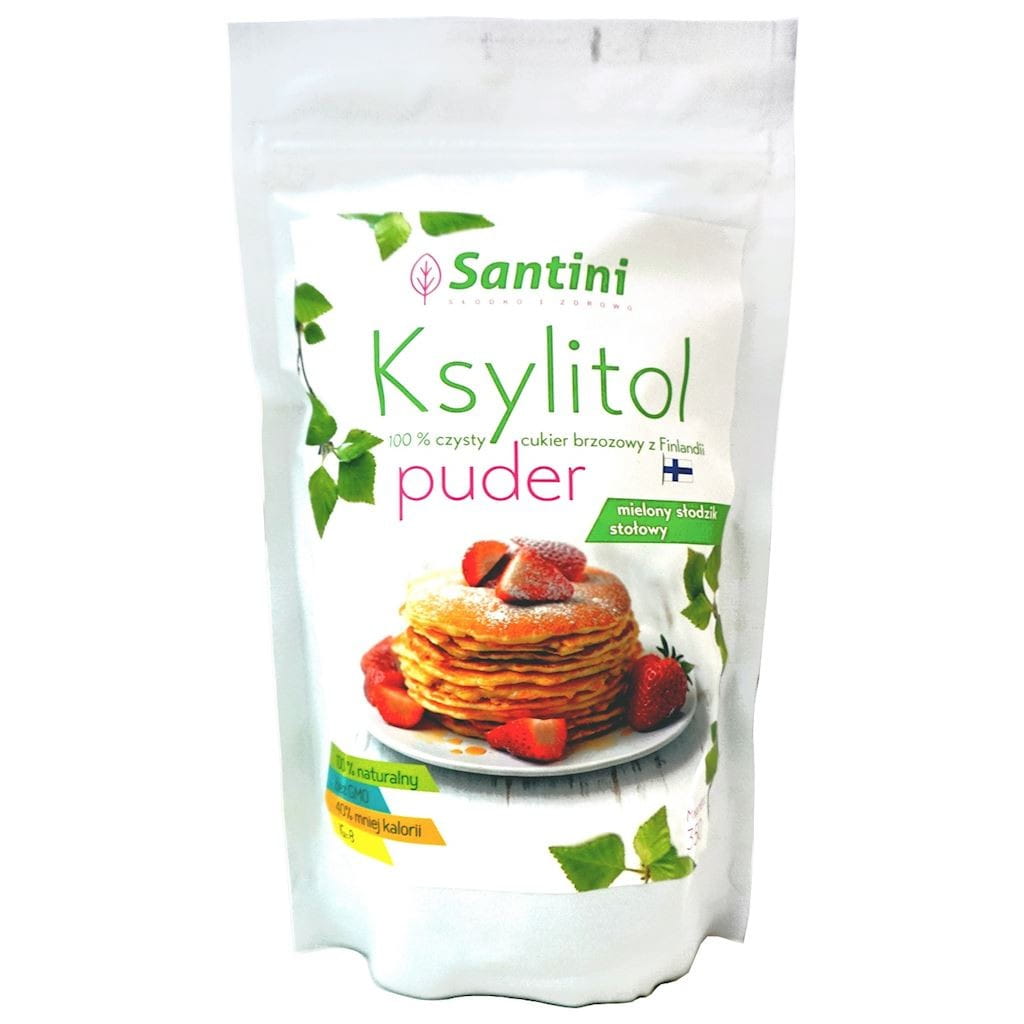Xylitol powder 350 g - SANTINI
- Regular price
- €10,60
- Regular price
-
- Sale price
- €10,60
- Unit price
- per
Couldn't load pickup availability
Description
xDESCRIPTION
- has 40% fewer calories than sugar
- 1 gram equals 2.4 calories
- glycemic index of xylitol is only 8
-lowers the pH in the mouth
-improves calcium absorption in the body
Xylitol is usually birch sugar, but can also be obtained from other plant products. It is a polyhydroxy or sugar alcohol, a derivative of xylose. Its structure stimulates the receptors responsible for the sweet taste on the tongue.
It occurs naturally in raspberries, strawberries, plums and even cauliflower. Finnish xylitol is xylitol extracted from birch. The term xylitol itself can refer to other fruits and vegetables. Then it is most often made from corn. Depending on the product from which it is extracted, we have different extraction methods. Birch is made by fermentation carried out by bacteria and yeast. The one made from corn, on the other hand, is produced by the hydrolysis of biomass.
Xylitol, which looks like sugar and even has a similar sweetness, differs from it primarily in calorie content. Its calorific value is much lower, even up to 40%. 1 gram is only 2.4 calories. Its glycemic index is only 8, for comparison: conventional sucrose has IG = 70 and glucose IG = 100. As a result, xylitol does not increase our blood sugar levels as much as conventional sugar. Therefore, it is well suited as a sugar substitute for people who should exclude products with a high glycemic index from their diet and do not want to do without sweetening coffee, tea or sweet snacks and cakes.
In foods, xylitol is most commonly found in chewing gum and candy. It is increasingly being used as a sugar substitute in healthy versions of candy and cakes. Perfect for sweetening coffee, tea, smoothies, desserts and ice cream. It is heat stable, so we can easily substitute xylitol for sugar in recipes.
The presence of xylitol in chewing gum is no coincidence. When xylitol is consumed, it is not fermented with bacteria and therefore no acids are formed that negatively affect tooth enamel. In addition, it lowers the pH of the oral cavity and increases the production of saliva, which has a positive effect on the condition of our teeth. Xylitol also facilitates the absorption of calcium, which is why it is worth including in the diet for people with deficiencies. However, it does have a downside, if consumed in excess it can cause depletion, so it pays to control the amount consumed throughout the day.
INTEREST
Our body is able to produce xylitol itself, this happens during metabolism during digestion.
By substituting xylitol for sugar in recipes, we add the same amount of sugar as regular sugar because its sweetness is similar.
In food it appears under the symbol E967.
INGREDIENTS
100% xylitol.
NUTRITIONAL VALUE PER 100 g
Calorific value: 1000 kJ / 240 kcal;
Fat: 0g
of which saturated fatty acids: 0 g
Carbohydrates: 99.8 g
of which sugar: 0.2 g
of which polyhydric alcohols (polyols): 98.5 g
Protein: 0g
Salt: 0.01g
RECOMMENDED STORAGE
Store in a dry place below 25 degrees Celsius.
similar products
- Regular price
- €10,60
- Regular price
-
- Sale price
- €10,60
- Unit price
- per
- Regular price
- €10,60
- Regular price
-
- Sale price
- €10,60
- Unit price
- per
- Regular price
- €10,60
- Regular price
-
- Sale price
- €10,60
- Unit price
- per
- Regular price
- €10,60
- Regular price
-
- Sale price
- €10,60
- Unit price
- per
- Regular price
- €10,60
- Regular price
-
- Sale price
- €10,60
- Unit price
- per
- Regular price
- €10,60
- Regular price
-
- Sale price
- €10,60
- Unit price
- per
- Regular price
- €10,60
- Regular price
-
- Sale price
- €10,60
- Unit price
- per
- Regular price
- €10,60
- Regular price
-
- Sale price
- €10,60
- Unit price
- per
- Regular price
- €10,60
- Regular price
-
- Sale price
- €10,60
- Unit price
- per
- Regular price
- €10,60
- Regular price
-
- Sale price
- €10,60
- Unit price
- per
Recently Viewed Products
- Regular price
- €10,60
- Regular price
-
- Sale price
- €10,60
- Unit price
- per
- Regular price
- €10,60
- Regular price
-
- Sale price
- €10,60
- Unit price
- per
- Regular price
- €10,60
- Regular price
-
- Sale price
- €10,60
- Unit price
- per
- Regular price
- €10,60
- Regular price
-
- Sale price
- €10,60
- Unit price
- per
- Regular price
- €10,60
- Regular price
-
- Sale price
- €10,60
- Unit price
- per
- Regular price
- €10,60
- Regular price
-
- Sale price
- €10,60
- Unit price
- per
- Regular price
- €10,60
- Regular price
-
- Sale price
- €10,60
- Unit price
- per
- Regular price
- €10,60
- Regular price
-
- Sale price
- €10,60
- Unit price
- per
- Regular price
- €10,60
- Regular price
-
- Sale price
- €10,60
- Unit price
- per
- Regular price
- €10,60
- Regular price
-
- Sale price
- €10,60
- Unit price
- per
- Choosing a selection results in a full page refresh.











